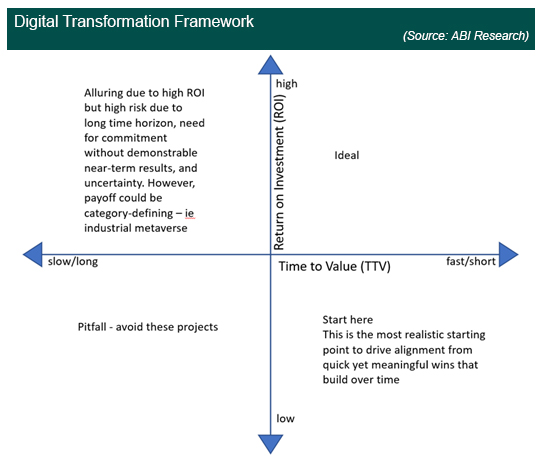Digital Transformation Impacts All
|
NEWS
|
Every manufacturer is impacted by digital transformation, the only question is to what extent. Many leading companies, including Mercedes-Benz, Volkswagen, and John Deere, have standardized their technology stack and have resources dedicated to the success of digital transformation projects at their plants. Others that have yet to fully embrace digital transformation see the need to act soon or risk being overrun by competitors better positioned to meet evolving customer requirements. Firms in both camps and everywhere in between must regularly evaluate—and prioritize—which digital transformation project to take on, and which to nip in the bud. ABI Research has developed a simple framework to help with the evaluation process, including a tool that can be used to answer two of the hardest questions: 1) where to start and 2) where to focus.
Return on Investment versus Time-to-Value
|
IMPACT
|
Historically, the prevailing sentiment for choosing where to place your bets was on the project with the biggest payback (i.e., Return on Investment (ROI)). Sometimes, it didn’t matter when that payback would occur, but a big payback was enough to drive alignment. The problem with this approach in the current macroeconomic environment is that most companies need to solve specific problems, rather than trial new solutions without a clear—and ideally incremental—near-term ROI. Projects that take a long time to come to fruition also risk failure due to a lack of urgency and the infrequency of feedback loops.
Time-to-value (TTV) is the new metric on which many companies have chosen to focus. The reason is that the time horizon for success in digital transformation projects has been naturally truncated, if those projects haven’t already been pushed off, as firms watch their finances. Projects with a short TTV help offset both financial and alignment challenges because they allow for quick feedback and recalibration. The quick nature of these feedback loops helps insulate teams from external risk and overall project failure, in addition to issues with mission creep and changes in project staffing.
A Simple Digital Transformation Framework
|
RECOMMENDATIONS
|
Ideally, you want to bet on projects with the biggest ROI and the fastest payback period/TTV. But these projects aren’t always easy to identify, if they even exist for your business. For that reason, two best practices are to know what kinds of projects to avoid, and how to apply a crawl-walk-run strategy. To perform this evaluation, ABI Research developed the following framework, where TTV is on the X-axis and ROI is on the y-axis.
- Lower Left Quadrant—Pitfall: Avoid these projects. They have low ROI and may take a long time to come to fruition. These are projects that should be outsourced or intentionally deprioritized and avoided.
- Upper Left—Alluring: These are whitespace opportunities that could take significant time to develop. The payback could ultimately be massive, but there is little guarantee of any meaningful returns on a near- to mid-term time horizon. One example is the industrial metaverse, and some would argue 5G.
- Upper Right—Ideal: Big ROI and fast TTV is a dream come true, but they are few and far between. They may be associated with a new, revolutionary technology introduction. Cloud technology is one such example.
- Lower Right—Start Here: These are projects that can be completed quickly, or have near-term milestones that deliver incremental business value. A best practice is to start with a quick win, such as connecting a single machine and performing condition-based monitoring, before building on it, such as connecting the entire factory for condition-based monitoring on fleets of machines.

ABI Research recommends that clients identify and focus on projects in the lower right quadrant. These projects should be small and achievable, yet meaningful. Over time, many small, yet meaningful projects will build to the big ROI that can otherwise seem a daunting achievement. Rather than pursue one large project, break it down into composable milestones, with each delivering immediate value, even if that comes as feedback on whether to move forward.

